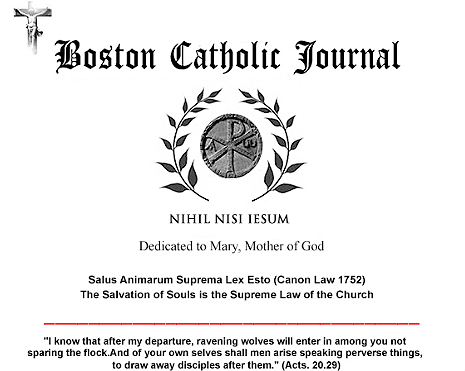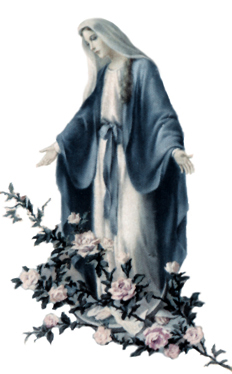

ADVENT
Mary ... the Paradigm of the Possible
in all that is Impossible to Man
Spes Nostra: Mary, our Hope in the
Twilight of Advent
By a Poor Clare
Cloistered Nun
“Salve Regina,
Mater misericordiae. Vita, dulcedo, et spes nostra, salve”
...
O n
the threshold of Advent many of us begin to experience a sense of anticipation
and excitement as we look forward in expectation to the happiness and
joy that we hope Christmas and its festivities will bring to us and
our families.
The reality, however, is that for many of us — and for reasons
that seem to multiply with our years — it may well come to us not as
a road to the fulfillment of our dreams (and so often our illusions),
but as an avenue through a Vale of Tears. Even our joy, however brief,
whispers somehow that it is the harbinger of sorrow. We find this echoed
in the beautifully composed Catholic hymn,
Salve Regina,
in which our voices are raised to the Queen of Heaven to whom, “we cry,
poor banished children of Eve, mourning and weeping in this vale of
tears”— or more literally, “to thee we breathe out (suspiramus)
our sighs...!”
“Ad
te Suspiramus, gementes et flentes ...”
Sometimes the pain within us swells up like a bitter-sweet anthem, as
painful in its beauty as it is sorrowful in its sound ... and the last
note uttered is ever a protracted sigh. At such times, we can do only
this ... breathe out our sighs to God and to His Holy Mother. And in
the quiet of that shallow breath, how often we empty our souls of all
hope ...
“in hac lacrimarum
vale”
But Mary is our Advent hope ... whose heel,
even now, is on that serpentine sorrow that wends its way through the
often dark and empty corridors of our lives! She is our Mother in our
motherlessness, our Queen in our broken servitude to sin, and she is
our hope in the looming despair which would crush us under both: our
sin and our sorrow.
Yes, even the joy of anticipation in Advent so often comes to us commingled
with sorrow. The festooned lights of our frail hope span the gulf of
our grief and we are led to a passing; a passing within ourselves through
a passing of all things. We are sojourners only, pilgrims withal, and
exiles in longing. It is the fabric of our being — as long as it is
a being-apart-from-God. In Advent, then, we come to a twilight,
and know not whether it precedes the dawn or the dark. How obscure is
this valley, as fraught with hope as it is with impending despair!
But there is one who dwelt in this twilight before us.
How little she, too, understood, comprehended, perceived! How anxious
her heart upon the threshold of the impossible; how obscure the way
through which God would become man, and how meekly she questioned, even
as she did not doubt, what was proffered by God! ... "How can this be?"
She knows our twilight, our consternation, our fear. “How can this be?”,
we ask of the promises of God — “how can this be?” ... that this valley
of tears will lead us to the summit of Paradise? That our sins without
number will be numbered no more? Will the salt of our tears become the
salt of the earth? And will this dust of the earth be raised up unto
God?
“Quomodo fiet istud?” — “How can this be?”
“Et
Verbum caro factum est!”,
we affirm with our lips, embrace with our hearts each Sunday at Mass:
“And
the Word became flesh, and dwelt among us!”
The Light came into this world, not in the day, but in the darkness!
It is Mary, then, whom we first find in this valley, “The Woman” who
preceded not God, but “The Man” Whom God assumed in His Son.
Mary ... the paradigm of the possible, in all that is impossible to
man, but is possible to God.
Yes, Mary is the Mother of hope!
“Et Iesum, benedictum fructum ventris tui, nobis post hoc exsilium ostende.
O clemens, O pia, O dulcis ,Virgo Maria.”
“And after this our exile, show unto us the Blessed fruit of thy womb
Jesus, O Compassionate , O Holy, O sweet Virgin Mary”
Pray with Mary this Advent; not simply to her ... but with her, for
her heart's desire is precisely what you ask of God: to lead you through
this vale of tears that, at Christmas, she herself may show you, in
the manger of your own poverty, the fruit of all hope, "the blessed
fruit of her womb, Jesus.”
A Poor Clare Colettine Nun
for the Boston Catholic Journal
|
SALVE REGINA
|
HAIL, HOLY
QUEEN
|
|
SALVE
REGINA,
Mater misericordiae.
Vita, dulcedo, et spes nostra, salve.
Ad te clamamus exsules filii Hevae.
Ad te Suspiramus, gementes et flentes
in hac lacrimarum valle.
Eia ergo, Advocata nostra,
illos tuos misericordes oculos ad nos converte.
Et Iesum, benedictum fructum ventris tui, nobis
post
hoc exsilium ostende.
O clemens, o pia, o dulcis Virgo Maria.
℣. Ora pro nobis, Sancta Dei Genetrix.
℟. Ut digni efficiamur promissionibus Christi.
Amen.
|
HAIL,
HOLY QUEEN,
Mother of Mercy;
our life, our sweetness, and our hope.
To thee do we cry, poor banished children of Eve;
to thee do we send up our sighs, mourning and weeping
in this valley of tears.
Turn, then, most gracious Advocate,
thine eyes of mercy towards us;
and after this our exile, show unto us the blessed
fruit of thy womb, Jesus.
O clement, O loving, O sweet Virgin Mary.
℣.
Pray for us, O holy Mother of God.
℟.
That we may be made worthy of the promises of Christ.
Amen
|
Audio
file:
Learn
the Salve Regina in Latin
 Printable
PDF Version
Printable
PDF Version

Totally Faithful to
the Sacred Deposit of Faith entrusted
to the Holy See in Rome
“Scio
opera tua ... quia modicum habes virtutem, et servasti
verbum Meum, nec non negasti Nomen Meum”
“I
know your works ... that you have but little power,
and yet you have kept My word, and have not denied
My Name.”
(Apocalypse 3.8)
Copyright © 2004
- 2024 Boston Catholic Journal. All rights reserved.
Unless otherwise stated, permission is granted by
the Boston Catholic Journal for the copying and
distribution of the articles and audio files under
the following conditions: No additions, deletions,
or changes are to be made to the text or audio files
in any way, and the copies may not be sold for a
profit. In the reproduction, in any format of any
image, graphic, text, or audio file, attribution
must be given to the Boston Catholic Journal.
|
|
|